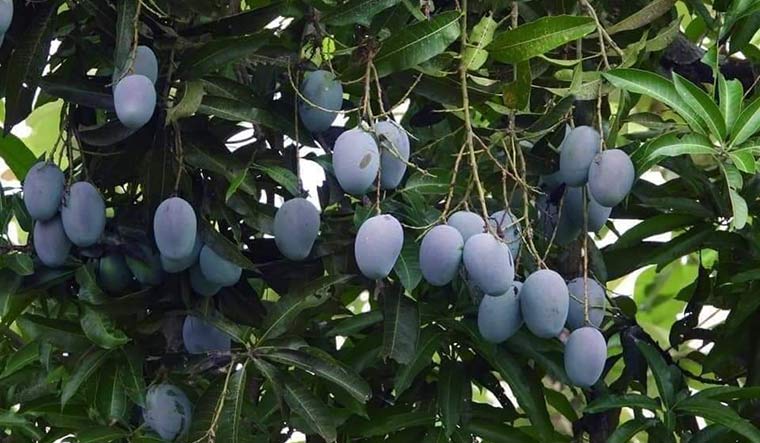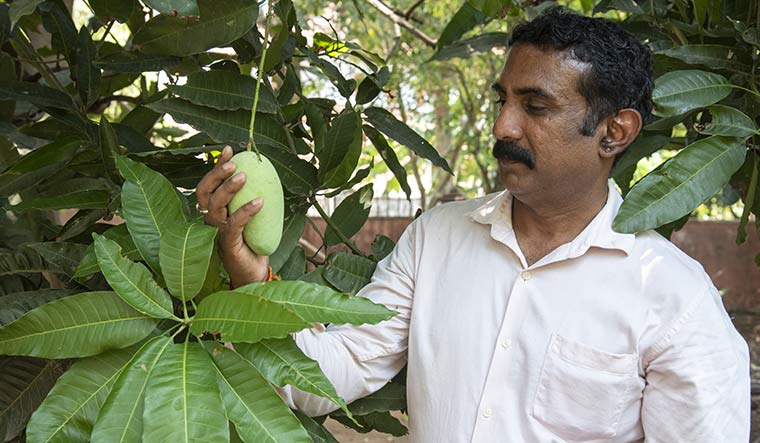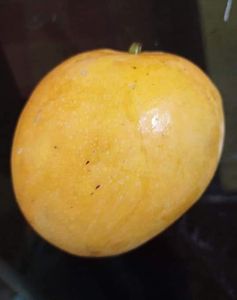The summer of 2020 was not a kind one. It was a scorching April afternoon when Sakhil Thaiyyil and friends reached Ottapalam in Palakkad, Kerala. As the road made a sharp turn, he noticed a gated house partly under the shade of a mango tree. The group stopped. On the other side of the gate, the woman of the house grew suspicious of the strangers staring at her property. When Thaiyyil asked her how good were the mangoes, she said, “Useless.”
The lady’s reaction did not surprise him, having had several such encounters. He did what he has always done―picked up a mango, half-eaten by a bird, from the ground and took a bite of its unbitten side. And, he was in sweet heaven. “Were you talking about this same tree, chechi (sister)?” he asked the woman. The fruit was fleshy with little fibre. The woman sheepishly replied that she was sleepy and was caught off guard by the group of strangers who wanted to know about a mango tree. When asked if the tree had a name, she was baffled. Who names trees in their compound? Thaiyyil spotted the name of her child scribbled on the steps leading to the house’s main door. “Shall we call it ‘Kunjoos’, then?” he asked. The family agreed.
Apart from ‘Kunjoos’, there is ‘Anaswara’, ‘Arya’, ‘Kairali’, ‘Thrissurkaaran’ and more. Most mangoes ‘found’ by Thaiyyil’s group are named with some reference to their discovery. “Mostly, it is nicknames of children. Obviously, you cannot give sweet mangoes adult names like Babu, Sabu,” he said, laughing.
 Budding success: ‘Dukhran’
Budding success: ‘Dukhran’
Thaiyyil is a founding member of the Indigenous Mango tree Conservation Project (IMCP), a social media community that tours the length and breadth of Kerala in search of endemic mango varieties that need conservation and promotion. The ever-growing team operates over a Facebook group called ‘Naadan Maavukal’ (indigenous mango trees), created in May 2019, that has over 60,000 members.
“We tour door-to-door across Kerala, every weekend of March, April and May when mango flowers blossom into fruits,” said Thaiyyil, who runs a dry fruits stall in Thrissur when not chasing mangoes. “Our members take down notes to identify more varieties. Each year, we find new types to share with the world.”
IMCP members call these trips ‘mango hunting’. They taste mangoes, and if good, ask the owners for a few more fruits. They will then produce saplings of the tree and distribute for free all over the state. Years of experience have helped Thaiyyil spot trees that may be unique. Large size, resistance to diseases, rare colour and aroma and a Brix measurement (sugar content) of 20 or more are among the qualities that can get a mango registered in their good books. Among the hundreds of varieties they have found so far, at least 100 are of fine quality and 50 are very unique, said the team.
Thaiyyil and his tribe are, in a way, custodians of the legacy of 19th-century priest and social reformer Kuriakose Elias Chavara, who, he claims, was a mango hunter. Moved by the delicious mangoes from Goa he got as a gift, the reverend asked the seeds of the tree to be grown across seminaries, monasteries and churches. He wanted the mangoes to be called ‘Dukhranan’, which meant ‘our remembrance’ in Syriac. But the devotees called them ‘Priyoor’ as Chavara was their prior back then.
Over a century and a half later, however, Thaiyyil and co ensured that Chavara’s wish was fulfilled. When a rare blue desi mango tree was discovered in a church in Thuravoor of Alappuzha―Chavara’s home district―they named it ‘Dukhran’ (remembrance).
But why should there be a dedicated team to sprouting mango trees? Because things are not that simple when it comes to the king of fruits.
“The natural survival rate of mango saplings is not that great,” said Thaiyyil. “Certain kinds become popular because of human intervention at some point in time. You take any famous mango variety and the story will be the same. But we have found hidden gems that can take the popular ones head-on.”
Mango seeds can be monoembryonic or polyembryonic. Monoembryonic seeds are the result of hybridisation and carry genetic traits from both female and male parent. Sprout them and the resulting trees will not bear the same fruit as their parents. In polyembryonic seeds, meanwhile, only one embryo is the result of crossbreeding; the rest carry genetic information from the mother tree and therefore produce the same fruit.
“Suppose a monoembryonic tree yields 2,000 fruits in a year,” said Thaiyyil. “If all the 2,000 seeds take root, none of them will possess all the characteristics of the mother tree. At least 500 will be entirely different.”
The group has distributed at least 10,000 mango plants in the last three years for free. The story of the ‘Mogral’ tree in Kasargod district is the best example of the group’s intervention. Thanks to its popularity among the villagers, the tree got its name from its location―the Mogral Puthur Panchayat office. Two fruits from the tree easily weighed over a kilo. The freshly plucked mangoes would never reach the market as they would be sold right under the tree for around Rs150 per kg. That was true even during the pandemic.
In 2021 though, the national highway broadening sealed the fate of the tree. The villagers were upset but knew the highway was a priority. They prepared to bid adieu to their favourite tree, slightly relieved that they had enough seeds to grow many more ‘Mograls’.
But the IMCP told the villagers and the panchayat that ‘Mogral’ was a monoembryonic tree, and hence one of a kind―cut the tree and the ‘Mogral’ is lost forever! The campaign resulted in the local body getting in touch with the Indian Council of Agricultural Research-Central Plantation Crops Research Institute so that grafting and budding methods could be adopted to ensure its rebirth. By the time the parent tree’s last days approached, Kasargod had over 5,000 grafted seedlings ready. The hunters had worked their magic, once again.
“Almost all famous varieties of Kerala’s mangoes are polyembryonic,” said Thaiyyil. “But we found that there are more delicious types than the popular ones. They were not found anywhere else despite being polyembryonic; there was just one tree―Kunjoos, Thrissurkaaran are examples of such varieties we found.”
Like other hunters, these mango hunters also live by a code. At no cost should the location of a parent tree be disclosed. “This is to protect the privacy of the families,” said Thaiyyil. “We can’t let people reach out to a family regularly seeking mangoes. You come to us if you need a plant. No one’s stopping you, provided you agree to our terms and conditions.”
And the terms are pretty simple. Those who take the plants home should post photos of them every three months in the community’s Facebook group. This is to confirm that the mango plant is alive and well. In case of stunt growth or diseases, fellow mango lovers can help with tips and solutions.
The Facebook group also does the marketing work. When they have saplings ready for distribution, a “mango review” with multiple videos and images of these saplings are posted. “We would have prepared 50 saplings, but will get over 200 inquiries,” said Thaiyyil. “We tell them enthusiasm alone won’t do. We need reviews on time. If you can do that, take the plants and go.”
Hyderabad-based Jayakrishnan V.U. was among the thousands of the group’s benefactors. He followed the rules to the T and now his ancestral land in Thrissur has several trees that yield mouthwatering mangoes. “I came to know about ‘Naadan Maavukal’ Facebook group and Ravi [T., member of the group] in 2021. I was working from home then. It was surprising to find such a huge collection of indigenous mango varieties in one place.”
Jayakrishnan’s first plant was ‘Kalkandapriyan’, a very rare variety. “Then, I went on to collect more types like ‘Chelan’, ‘Oloor’, ‘Ivory Kolambu’, ‘Thrissurkaaran’ from other members of the group. Now I have more than 15 mango varieties on my farm,” he said. “This group made me a custodian of local varieties that are fast disappearing from Kerala.”
But societal commitments and pressure sometimes force them to give away plants in bulk to organisations headed by individuals they are close to. “Most trees distributed on June 5 (World Environment Day) and other occasions die because of lack of care,” said Thaiyyil. So, we charge groups to whom we cannot say no. If it is children or youth clubs, we ask them to get us fertile soil or tree bags as barter.”
Wandering around Kerala in summer is no mean feat. Add to it people who could be wary and rude. It takes earnest efforts to win them over and open their gates. Thus, people skills become important.
“People naturally become suspicious. Some do not buy the fact that a team from Thrissur travelled all the way to Thiruvananthapuram or Palakkad to taste mangoes,” said Ravi. Things have become a little easier after the Facebook group’s membership grew. “We try not to offend them at any cost,” he said. “Some budge after realising that we can make them famous by naming the mango after them. With others, we plead and beg and show readiness to do as they demand.”
In Thiruvananthapuram, things are a tad easier for the team as they have a woman member. Jayasree Bhadran, who works at the Kerala Legislative Assembly, became an active member of the Facebook group during the pandemic. Today, she is a core member of the group in southern Kerala. ‘Pancharaneela’, ‘Chakkarakurissi’ and ‘Nalanda’ are among the indigenous varieties the group found in Thiruvananthapuram, she said.
In a way, it was the coincidental discovery of ‘Nalanda’ that led to Bhadran becoming an active hunter from a passive member of the Facebook community. She was among the few who reported to work during the pandemic, and as always saw the tree on the way to Nalanda, a locality, from Nathancodu Junction. But then, she had never seen the tree in all its glory. “Every season, local residents would pluck baby mangoes in bunches to make pickles, and the public works department would auction whatever was left of the mangoes,” she recalled. “All this stopped during the pandemic, and we noticed it in its full majesty, brimming with golden gems. It had a peculiar taste and texture.” She packed a dozen of the fallen mangoes and took it to office. A colleague posted an image of the mangoes on Naadan Maavukal, and the rest is history.
When Kerala University started a project to preserve indigenous mango varieties, they contacted Bhadran’s unit, which helped locate about 10 varieties.
“Some nurseries have started to follow our modus operandi,” said Thaiyyil. “We are happy as it makes our jobs easier. Fame and records hardly allure us, it is just the cause we are bothered about.”
But why go through so much trouble to preserve mango varieties? “I only have 20 cents, and there are only so many trees I can grow,” said Thaiyyil. “So I thought, ‘why don’t I just donate a mango sapling each to all my neighbours?’ After all, they will give a share of the fruits out of courtesy. This was the original thought.”
And Thaiyyil thinks that there is no better gift than a mango sapling. “I still tell people to plant mango saplings at the homes of people they really care for,” he said. “That is the best gift you can possibly give. They will remember you every time the tree bears fruit.”
(Sakhil Thaiyyil can be reached at +918138054072)




